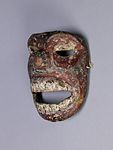Mask
About this object
History of use
Worn during curing ritual of the Sanni Yakuma ceremony, part of the Tovil series of dramas performed by Sinhalese ritual specialists and dancers. The Sanni Yakuma is intended to combat diseases and afflictions caused by the Sanni group of demons. These consist of 18 or more apparitions of the chief demon, Maha-kola-sanni. The officiating healer honours Buddha, then appeases the demons with offerings, dancing, and chanting. Mask represents Golu Sanni, the demon of dumbness.
Cultural context
exorcism
Iconographic meaning
Red-brown colour symbolizes blood thirsty men and demons. Open mouth suggests unsuccessful attempt to speak, or dumbness.
Physical description
Mask depicting Gulu Sanniya (which represents dumbness) with deeply set eye sockets, a prominent blunt nose, a very large open mouth with lips drawn back to show protruding teeth, and a low forehead. The eyes have large black irises with a white dot at the centre, and the top half of each eye is outlined in black. The teeth are painted white and outlined in black, and the face is painted dark red. There is a hole in either side of the mask at the top of each cheek, and a strip of off-white cloth has been attached through the holes.
Categories
Materials
